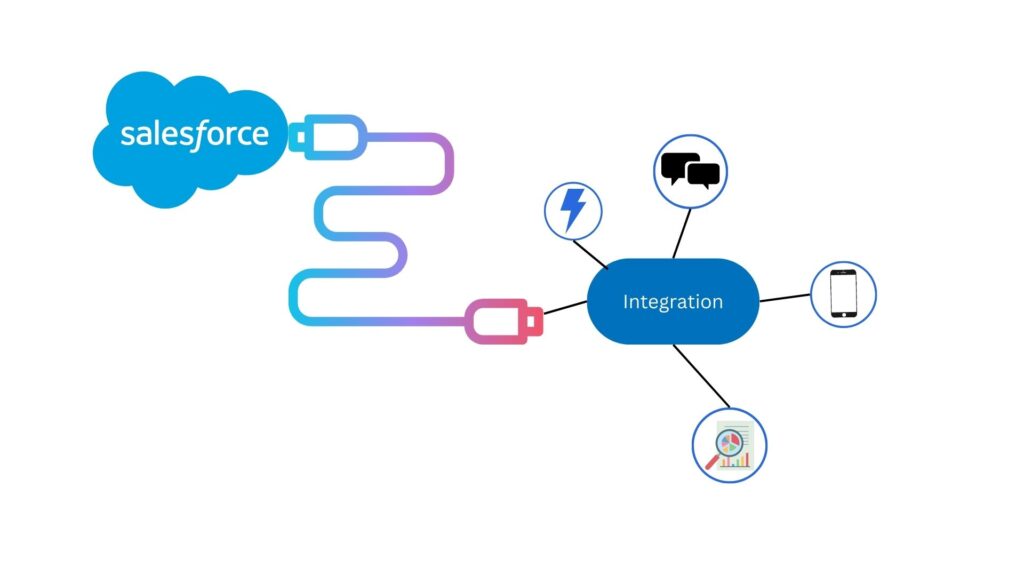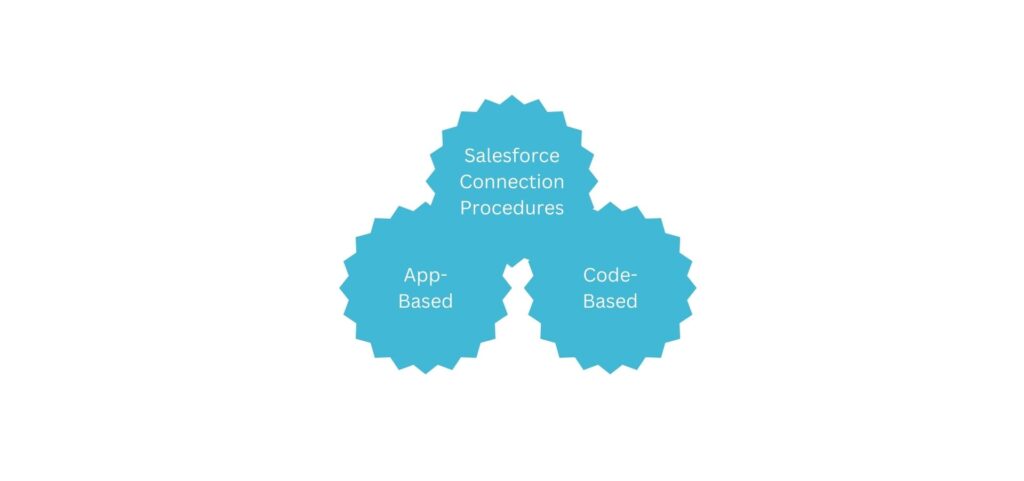Salesforce integration is the process of combining Salesforce’s data and features with those of another program to provide users with a unified experience. It enables you to offer the perfect balance of functionality from both platforms to your workforce.
Users of Salesforce frequently struggle with the problem of synchronizing data between two platforms and switching between them when carrying out tasks. They have been freed from this issue thanks to Salesforce connectivity, which also gives them a consolidated workspace.

Salesforce Integration Types
Numerous company sectors link their CRM to other systems at the process and data levels. These may be further broken down into the three fundamental types of integration in Salesforce, which are detailed below:
-
- Data Integration: When syncing data from two or more systems, data integration is employed. Consequently, all integrated extensions will exchange real-time data. Data integration is accomplished through SOAP and REST Salesforce API integration.
- Integration of Business Logic: The incorporation of business logic paves the way for the development of reliable, all-encompassing business solutions that incorporate a range of back-end programs and applications. Apex Web Services are used for inbound communication, while Apex Callouts are used for outbound communication in this context.
- User Interface Integration (UI): If a centralized user experience must be offered to all users, UI integration is a sensible choice. It is the most effective technique to display several apps in Salesforce. The clients are given a single objective to segment into several applications. A good illustration of this is the phenomenon of Facebook applications, the content of which is provided by several other programs even though they appear to be products of Facebook.
Factors to Consider Before Salesforce Integration
-
- Examining the API limitations for both apps
- How to determine the integration type (real-time or batch integration)
- Keeping track of the system’s authentication
- Developing a customized API to call external APIs for the additional data that is required
- Recognizing available configuration options
- Knowing that information should not be shared across the two platforms
Salesforce Integration Procedures
App-based and code-based are the two main methods used to carry out the Salesforce connection procedure.

Integration with Salesforce via apps
App-based Salesforce integration, as the name implies, uses specific applications to carry out the integration process. With a few clicks, customers may utilize these applications to seamlessly combine the data from two different apps and create a single platform.
A reliable and seamless integration platform that enables the seamless movement of data between the two apps is required to link your Salesforce CRM with relevant applications.
Integration with Salesforce via code
Salesforce integration is possible without the need for specific programs by using a computer language. The most prevalent instance of a code-based Salesforce connection is Apex. With a syntax resembling that of Java, it is a proprietary programming language.
Implementing code-based Salesforce connectivity with Apex has some key advantages, including:
-
- Integrated support for the Salesforce Lightning Platform
- A user-friendly and easily comprehended language
- Compatible with various API versions
- On the Lightning Platform, the programming language may be hosted and fully managed
Best Way to Integrate Salesforce
Four goals may be used to outline what businesses typically want to accomplish when they deploy ERP combined with Salesforce CRM:
-
- 360-degree consumer perspective
- Efficiency improvement
- A greater uptake by users
- Eliminating the requirement for manual data re-entry.
- A clear definition of the purpose would therefore be the first step to successful integration.
The specifics of each integration scenario will vary based on the needs of the organization. A long-term company plan must consider the integration process.
Lack of leadership engagement and business policy is one of the major factors that might slow down and diminish the efficiency of Salesforce integration. The explanation is that initiatives involving data management can be extremely sensitive topics inside the firm, and not all departments may be on board. Additionally, while obtaining the cooperation of more executives may be crucial, the IT department will undoubtedly play a significant role in this kind of endeavour.
The identification of important integration points must be explored next. The key emphasis would be on selecting precisely what you want to integrate because the integration process may be completed in a very short amount of time with little to no change to the original code. Accounts, contacts, item prices, sales orders, payments, and other elements are among the most often used interconnection points.
Benefits of Salesforce Integration
- Salesforce offers centralized access. The necessary information will be available without the need for employees to transfer systems. If they are logged into the same system, they may do all of their tasks.
- With the Salesforce connection, productivity may be boosted. Teams use a lot of cutting and copying to make sure that data is present in all systems. Systems that are interconnected include automatic checks and balances to make sure they have the same information. As they won’t have to duplicate as much data, employees will be able to do more.
- Access to data has been made easier thanks to the integration with Salesforce. There is more data accessible, and it can be converted into meaningful knowledge. Additionally, data retrieval is simpler.
- Communication is enhanced via the connection with Salesforce. Some departments may favour using Salesforce while others prefer using a different system. By fusing the two systems, it will be possible for each team to work within the framework of their own choice, improving communication and information sharing.
- Code is not necessary to automate workflows. Because connected systems operate well together, automating their operations only requires a few mouse clicks.
- The Salesforce connection enables more thorough reporting. It will be easier for employees to make wise judgments and carry out the best possible activities since they will receive more thorough and pertinent reports.



